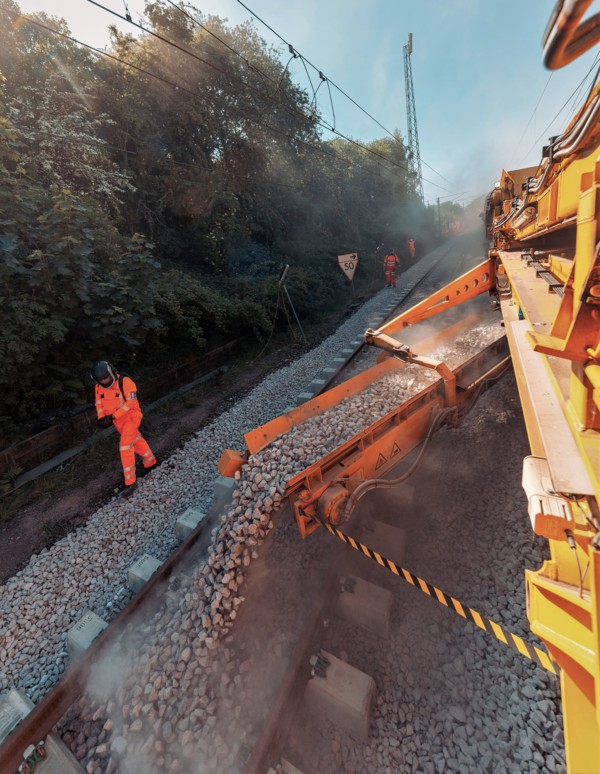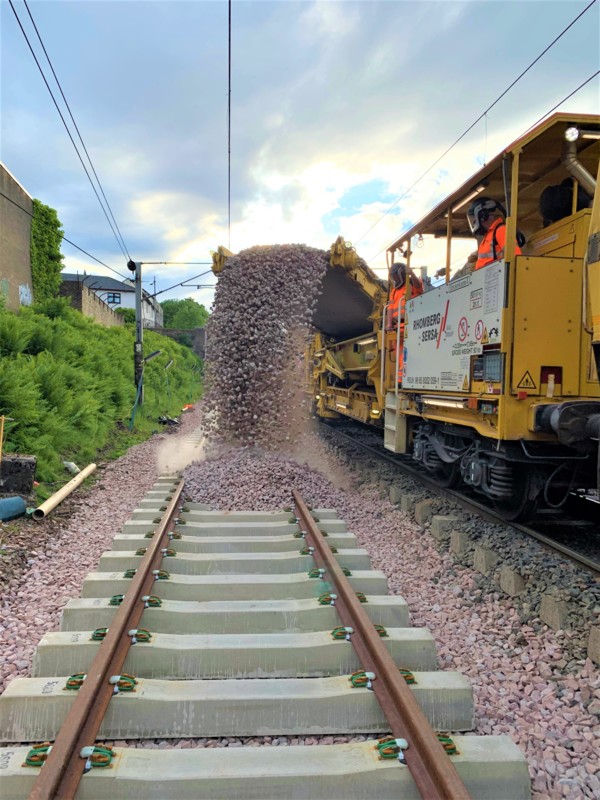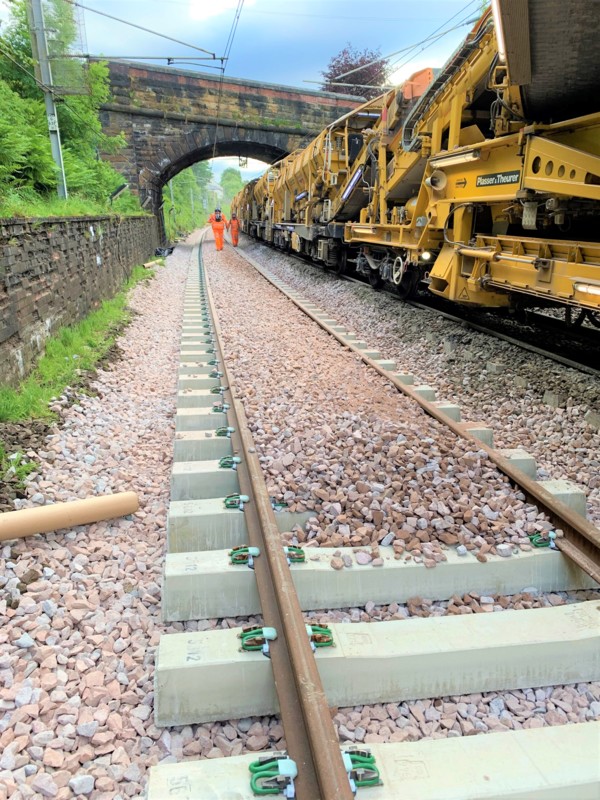Rhomberg Sersa’s Swiss Army Knife
When someone who has had over forty years in the railway industry says that a machine is probably one of the most versatile railway materials handlers available, it is time to take notice!
When someone who has had over forty years in the railway industry says that a machine is probably one of the most versatile railway materials handlers available, it is time to take notice!
Tony Fazekas, business development manager for Rhomberg Sersa, started his railway career dealing with the very first stone-blowers and ballast cleaners and, in his time, has seen many ‘big yellow machines’ come – and go. His view of Rhomberg Sersa’s Universal Materials Handling machine (UMH) is that it is “the Swiss Army knife of railway machinery for delivering material to and from site”. The UMH is part of Rhomberg Sersa’s ‘Machine Group’.
Over the past three issues of the Rail Engineer we have looked at the Rhomberg Sersa system and the machines involved. Observant readers may have noticed that two machines in the system – the ITC and the MFS+ - have been covered in some detail. (Rail Engineer volumes 181 and 182). The final machine, the UMH, appears at first to be a little difficult to write about. What is there to say about a machine that just dumps stuff? Well, in fact, there’s quite a bit to tell, and a conversation with Tony is a quick way to find out - and to be corrected.
The UMH – Swiss Army Knife – does dump stuff, but it is the way in which it does the dumping that can inspire so many varied ways of planning a project.

To recap, the UMH is a rail-mounted, materials-handling machine. Unlike its companion machines the ITC and the MFS+, it does not have retractable caterpillar tracks. It is usually marshalled at the end of a rake of MFS wagons (the ones with a conveyor all the way along for loading and unloading aggregates and other material) – although it is compatible with many other items of rolling stock. It can travel at 60mph and has a RA1 route availability. It appears to be a completely conventional wagon, kitted out with several systems of conveyor belts.
New or spent ballast is fed into the UMH from the conveyors of linear wagons at the rear of the machine, initially onto the lower handling conveyor. The UMH is thus directionally sensitive - which is another way of saying that it has to be marshalled the right way round within a train and the whole train has to be the right way round as well!
From the initial handling conveyor, the material is directed to one of three other conveyor systems. The upper conveyor can swing sideways - out to 90° to the machine, an arc of 180°. It has a reach of up to 5.6 metres either side of the centre line of the track that the machine is standing on and has a capacity of up to 400m³/hour (about 800 tonnes/hour). This conveyor can be used to feed materials into wagons on adjacent lines, to deliver bottom ballast for spreading by dozers or for the rapid distribution of material for civils works such as bank slips.
The other two conveyor belts are on arms, one each side of the UMH and located towards the base of the machine. These can handle up to 200m³/hour (about 400 tonnes/hour) and are used for the precise placement of bottom ballast, top stone and shoulders, as well as drainage-trench and landslip materials. These arms can swing out independently - up to 65° from the machine’s centreline - and they also have a reach of 5.6 metres from the centre of the track.
There is also a gravity system that can deliver accurate quantities of stone for maintenance runs or for top-up around the shoulders.
So far, mention has been made of ‘materials’. These can include both new or spent ballast, along with other coarse materials used in off-track projects. If the MFS and MFS+ vehicles can handle it then so can the UMH – very quickly and accurately.
Although confined to a railway track – it does not have caterpillars like the aforementioned MFS+ - the UMH needs not be a static piece of plant. On the contrary, it can spread materials whilst on the move. With an engineering supervisor coordinating the specialist operators throughout the train, the whole system can be used at a crawling pace to spread stone very precisely over long distances.
Part of Tony’s career involved travelling round Europe to explore how machines that had been developed and used over there could be brought across to the UK. Engineers in Europe have been using MFS+ vehicles, ITC machines and UMH machines for around twenty years.
Is there a natural translation of techniques? Well, it has to be acknowledged that the UK structure gauge proves to be a challenge on many occasions. Almost all of the kit from Europe has to be specially built or specially adapted, both to fit into the UK’s relatively constraining envelope and to meet today’s rigorous safety requirements, which is why all of the Rhomberg Sersa machines are fitted with dust-suppression systems. Nevertheless, Rhomberg Sersa has invested in three types of specialist kit.
There is the ITC, a derivative from the mining industry, used to excavate at the ‘coal face’ end of a job. There is the MFS+, a track and tracked machine that adds enormous flexibility to single line renewals planning, and the UMH for getting rid of ‘stuff’ or bringing ‘stuff’ to site – quickly.
Rhomberg Sersa has one ITC machine, two MFS+ machines and three UMH machines. With the exception of the ITC, these are all planned through the national NROL (Network Rail Online Logistics) system, so that a client can rely on everything that is needed for a project turning up – and turning up the right way round.
This series of Rail Engineer articles has identified the advantages of the machines in the Rhomberg Sersa Machine Group. They all have their specific basic uses, but it is up to UK engineers to learn how these ‘normal’ tasks can be varied. This certainly applies to the UMH machine. It has a basic job – which is to dump stuff – but there are many ways in which its flexible methods of dumping can be used.

Tony took pains to describe how materials for landslip remedial works can be speeded up with innovative planning, how the number of items of plant can be reduced and the number of staff at risk around these machines can be minimised when material is delivered in large quantities and delivered precisely.
Railway plant doesn’t have to be used only on track projects. Graded materials can back-fill drainage trenches or other construction without the disturbance that can be caused by conventional plant. The UMH really is the Swiss Army Knife of railway engineering. If someone who has seen forty years of railway engineering says so, then take notice!

The UMH is a standard railway vehicle consisting of a collector belt, a swivelling conveyor, a mid-mounted chute delivery system and two ballasting belts arranged beneath the frame on both sides of the vehicle.
Bulk material from multiple MFS Universal Material Handling Vehicles can be discharged onto the collecting belt of the UMH and distributed through the three systems, depending on the required application.
Bringing innovation and engineering excellence to the rail sector
You can find the article in Rail Engineer here.